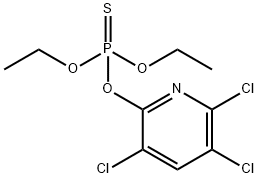2921-88-2

Product Name:
Chlorpyrifos
Formula:
C9H11Cl3NO3PS
Synonyms:
0,0-Diethyl-O-[3,5,6-trichloro-2-pyridyl]phosphorothioate;Chlorpyriphos
Inquiry
CHEMICAL AND PHYSICAL PROPERTIES
| Physical Description | Chlorpyrifos is a white crystalline or irregularly flaked solid. It has a very faint mercaptan-type odor. It is not soluble in water. It can cause slight irritation to the eye and skin. |
|---|---|
| Color/Form | White granular crystals |
| Odor | Mild mercaptan odor |
| Boiling Point | 320 °F at 760 mmHg (Decomposes) (NIOSH, 2023) |
| Melting Point | 108 to 110 °F (NTP, 1992) |
| Flash Point | 82 °F (CLOSED CUP) /DURSBAN 4E/ |
| Solubility | approximately 2 mg/L at 77 °F (NTP, 1992) |
| Density | 1.4 (Liquid at 110 °F) (NIOSH, 2023) - Denser than water; will sink |
| Vapor Density | 12.09 (calculated) (NTP, 1992) - Heavier than air; will sink (Relative to Air) |
| Vapor Pressure | 1.87e-05 mmHg at 77 °F (NTP, 1992) |
| LogP | log Kow = 4.96 |
| Henry's Law Constant | Henry's Law constant = 3.55X10-5 atm cu-m/mol at 25 °C |
| Stability/Shelf Life | Stable under recommended storage conditions. |
| Decomposition | Decomposition temperature: approx 160 °C |
| Corrosivity | Corrosive to copper and brass |
| Dissociation Constants | Practically non-dissociative by nature |
| Collision Cross Section | 201.7 Ų [M+H]+ [CCS Type: TW, Method: calibrated with polyalanine and drug standards] |
| Kovats Retention Index | 1947 1967 1951.4 1927 1997 1940 1955 1982 1966.1 1956.9 1971 |
| Other Experimental Properties | Heat of sublimation 26,800 cal/mol /From table/ |
| Chemical Classes | Pesticides -> Organophosphate Insecticides |
SAFETY INFORMATION
| Signal word | Danger |
|---|---|
| Pictogram(s) |
 Skull and Crossbones Acute Toxicity GHS06  Environment GHS09 |
| GHS Hazard Statements |
H301:Acute toxicity,oral H410:Hazardous to the aquatic environment, long-term hazard |
| Precautionary Statement Codes |
P264:Wash hands thoroughly after handling. P264:Wash skin thouroughly after handling. P270:Do not eat, drink or smoke when using this product. P273:Avoid release to the environment. P391:Collect spillage. Hazardous to the aquatic environment P301+P310:IF SWALLOWED: Immediately call a POISON CENTER or doctor/physician. P405:Store locked up. |
COMPUTED DESCRIPTORS
| Molecular Weight | 350.6 g/mol |
|---|---|
| XLogP3 | 5.3 |
| Hydrogen Bond Donor Count | 0 |
| Hydrogen Bond Acceptor Count | 5 |
| Rotatable Bond Count | 6 |
| Exact Mass | 348.926284 g/mol |
| Monoisotopic Mass | 348.926284 g/mol |
| Topological Polar Surface Area | 72.7 Ų |
| Heavy Atom Count | 18 |
| Formal Charge | 0 |
| Complexity | 303 |
| Isotope Atom Count | 0 |
| Defined Atom Stereocenter Count | 0 |
| Undefined Atom Stereocenter Count | 0 |
| Defined Bond Stereocenter Count | 0 |
| Undefined Bond Stereocenter Count | 0 |
| Covalently-Bonded Unit Count | 1 |
| Compound Is Canonicalized | Yes |
PRODUCT INTRODUCTION
description
Chlorpyrifos is an insecticide that is a white crystal-like solid with a strong odor. It does not mix well with water, so it is usually mixed with oily liquids before it is applied to crops or animals. It may also be applied to crops in a capsule form. Chlorpyrifos has been widely used in homes and on farms. In the home, it is used to control cockroaches, fleas, and termites; it is also used in some pet flea and tick collars. On the farm, it is used to control ticks on cattle and as a spray to control crop pests.
